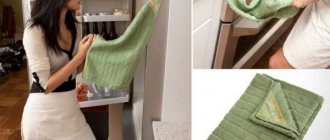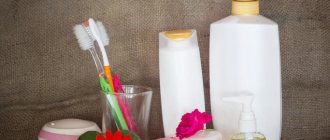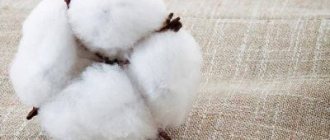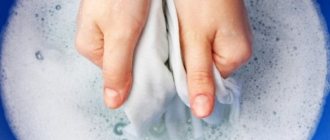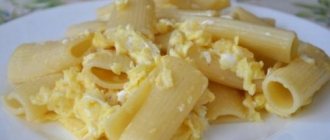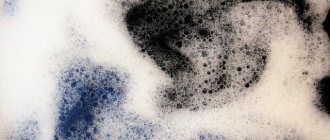How to keep fabric clean
To make towels last longer, you need to:
- After drying or if ironing towels with steam/spray, make sure that not even half a drop of moisture remains on the fabric. Otherwise, mold will begin to eat the fibers.
- Dry textiles at a temperature not exceeding 60 degrees.
- Avoid drying towels on radiators.
- Use different towels for hands and dishes, and viscose or other napkins for wiping tables.
- If you like terry hand towels in the kitchen, choose small, relatively thin ones and change them every day - fluffy textiles quickly pick up dirt and grease, and wash worse than smooth linens.
- Keep plenty of towels so you can change them and wash them as soon as a stain is discovered: stains that are several days old are difficult to remove.
- Give preference to oxygen bleaches and laundry soap. Carry out boiling no more than once every 30 days.
- Wash colored textiles only with gentle detergents.
Sparkling white kitchen towels are aesthetically pleasing and once again emphasize the housewife’s homeliness. Keep textiles clean and remove dirt promptly. If the stain has already dried and become ingrained, use one of the described methods, and the original color will return to the fabric.
Tips on how to quickly and safely wash kitchen towels in the microwave
To ensure that towels do not lose their visual appeal and are odorless, they must be washed and updated in a timely manner. Old stains either don’t come off well or don’t come off at all. With repeated exposure to detergents, kitchen textiles lose color and become thinner.
Terry products should be excluded from use in the kitchen. There should be several towels and napkins at the same time: one for wiping hands, a second for dishes, a third for wiping the table.
Used towels should be placed in a container with holes so that they are ventilated, otherwise an unpleasant odor will accumulate. When washing towels in a plastic bag, you need to set the time for no more than 1.5-2 minutes, otherwise they may catch fire. It is better to repeat the procedure if necessary, waiting for the products to cool.
There is no need to load a large amount of textiles into the washing machine or microwave at the same time. If the towels are large, it is better to wash them one at a time.
The microwave must be supervised during washing. Since a sufficient amount of water is used during washing, it is necessary to prevent splashes from entering the outlet to avoid short circuiting.
For bleaching, it is better to use an old microwave, which is not used for heating food. If this is not possible, and there is only one microwave, then it is necessary to take measures to eliminate the chlorine smell. To do this, you can boil the textiles several times in plain water and leave the microwave door open for ventilation. Any microwave must be thoroughly wiped inside to remove splashes and drips.
Washing in a microwave oven
To treat soiled textiles you will need:
- laundry soap;
- water;
- microwave;
- durable plastic bag.
If you need to wash white fabric using this method, you can use bleach instead of laundry soap. For fabrics that have a lot of greasy stains on them, dishwashing detergent is suitable.
You can wash no more than three small towels at a time in the microwave. The best way is to process them one at a time.
Instructions
Standard microwave washing is suitable for cleaning linen and cotton kitchen towels. The texture of the material can be smooth, waffle or with pile. For very soiled items, it is advisable to use stain pre-treatment.
For washing to be successful, you must follow these instructions:
- Moisten the towel.
- Squeeze out excess water.
- Lather the fabric, paying attention to particularly dirty areas.
- Place the fabric in a strong plastic bag. There is no need to tie it.
- Place the bag on the microwave tray.
- Set the power to 500 W.
- Set the regulator for 1.5 minutes.
- It is better to remove the towel with special tongs, as the fabric is very hot.
- After the fabric has cooled, it is recommended to repeat the microwave treatment. If after the first stage the towel has not heated up to a hot temperature, then repeated treatment is mandatory, since without it the result will be ineffective.
- Remove towels after re-processing.
- Fill a basin with water.
- Dip kitchen textiles into water.
- Rinse.
- Dry.
As an option, rinse the towels not with your hands, but with the help of a washing machine on the “rinse” mode.
How to wash kitchen towels using a microwave without boiling, video instructions:
Removing stains
If the towel fabric is excessively stained with various stains, the use of additional treatment will help to cope with the stains . To do this, you need to know what substances to remove each type of stain.
| What caused the stain? | What will help remove the stain? |
| Coffee | Salt |
| Mold | Vinegar |
| Tomatoes | Lemon juice or citric acid |
| Beet | Lemon juice or citric acid |
| Fat | Dishwashing liquid |
If the material is initially very dirty, it is recommended to use Antipyatin or another similar product instead of laundry soap.
Whitening
A separate recipe can be used for white towels. A prerequisite is their natural composition, which will survive digestion.
Using this recipe for colored fabrics, as well as those with prints, can lead to discoloration of bright colors.
To do the washing you need to prepare:
- a special, deep enough container designed for a microwave oven;
- water;
- a plastic lid used in a microwave oven;
- bleach (powdered or liquid).
Procedure:
- Heat water to hot temperature.
- Pour heated water into the container to fill 2/3 of the volume.
- Dilute bleaching detergent in water in a high concentration (0.1 kg per 1 liter of liquid).
- Dip the towel into the container. It is not necessary to completely immerse the item in water.
- Cover the container with the prepared lid. This will prevent liquid from splashing all over the inside of the microwave.
- Set the power to 500 W.
- Set the wash duration to 10 minutes.
- After washing, you need to remove the towel with tongs.
- Rinse the product.
- Dry.
In a similar way, you can bleach not only kitchen towels, but also other textiles that are allowed to be boiled.
How to bleach kitchen towels in the microwave
In addition to colored kitchen napkins and towels, there may be white textiles in the kitchen, which are difficult to bring to a snow-white state without bleaching. There is another recipe for them, which is acceptable only for natural fabrics that can withstand boiling. You will need:
- a container with a plastic lid intended for the microwave;
- any bleach.
Step-by-step algorithm:
- Pour hot water into a container, add bleach at the rate of 100 g per 1 liter of water.
- Immerse the textile completely in the liquid and close the lid.
- Set the power to 500 W, time - 10 minutes.
After turning off the microwave, rinse items in warm or cold water. And for bleaching, household chemicals are used, both containing chlorine and those based on active oxygen - this method allows you to bleach kitchen towels quickly and efficiently.
How it works?
Washing kitchen towels in a microwave oven is the same as boiling them for several hours. Just don’t waste a lot of time, breathe in harmful steam emissions and waste gas or electricity for a regular stove. The essence of the method is that when heated under the action of waves, foreign particles between the fibers of the fabric are destroyed, the detergent penetrates deep, combines with unnecessary elements (food residues, dyes, fat) and removes them from the fabric. During rinsing, the dirt and detergent are washed away, leaving the fabric clean, without stains or unpleasant odors.
- Save
How to remove stubborn stains using this method?
It is recommended to prepare the dirtiest towels before washing them in the microwave. To deal with difficult stains, use the following along with detergents:
- for traces of beets and tomatoes - citric acid;
- for moldy stains - acetic acid;
- from dried coffee - salt;
- greasy stains - dishwashing detergent.
The procedure for removing heavy stains is the same as for simple washing in the microwave described above. Instead of soap, it is better to treat the fabric with Antipyatin, add powdered bleach, or use dishwashing liquid. After this, also fold the laundry into a bag (no more than 3 towels), place in the oven for one and a half minutes at a power of about 450.
Step-by-step instructions on how to wash kitchen towels in a microwave
The microwave washing method is not only simple but also economical. It does not require expensive washing powder and other household chemicals; you only need ordinary laundry soap and a durable plastic bag.
In fact, the method of washing in a microwave boils down to boiling, but it does not cause unpleasant sensations from fumes and speeds up the process. Under the influence of waves, the dirt between the fibers is destroyed, the detergent penetrates deep inside, making the product easy to wash. Algorithm:
- Soak the towels and rub them with soap; the temperature of the soaking water does not matter.
- Pack the soaked towels into a bag without tying them.
- Set the power to 500 W and time to 1.5 minutes.
- After washing, remove the bag with wooden tongs.
- Rinse. Manual rinsing can be replaced by machine rinsing.
If there are old stains, repeat the procedure several times.
If the towels contain beetroot stains or traces of tomato, then before washing, you should pour citric acid onto the stained areas, salt will deal with coffee stains, and vinegar will help remove mold. Grease stains can be filled with dishwashing liquid.
Advantages of this method:
- saving time;
- absence of unpleasant odor and fumes, as when boiling;
- simplicity;
- harmlessness - you don’t have to breathe steam mixed with detergent powder;
- high efficiency;
- protecting fabric from damage;
- Any detergent will do, including laundry soap.
If after the first wash the towels are not warm enough, you need to repeat the procedure. It is better to wash soft towels with long pile not with laundry soap, but with hair shampoo, so they will retain their softness. Terry towels are not recommended for use in the kitchen, as they are more difficult to wash, and with frequent washing they will quickly lose their visual appeal.
We wash bath towels from dirt
Bath towels, their name definitely speaks about the scope of their application. Many people are surprised that such towels get dirty very quickly, because, in fact, we dry ourselves with them after we have thoroughly washed ourselves with “detergents”.
In fact, there is nothing surprising, because:
- not everyone washes perfectly and thoroughly
- even if the body is well washed, a certain percentage of dirt remains on it, which is clearly visible on a towel, especially a light one
In principle, bath towels are washed using the same technology as terry towels. In this case, it is also important that after washing it does not tear off your skin, but glides gently and smoothly over your body and wipes away moisture from it. To do this you only need two things:
- don't use a lot of powder
- use laundry conditioners
Since such towels are used directly in baths, showers, and saunas, it is very important that the following does not remain on the towel:
- fungus
- musty smells
- various kinds of microbes
Therefore, they need to be washed frequently to prevent unpleasant odors. Pay special attention to towels that are used in public places - saunas, baths, communal showers, etc. Wet towels very quickly “grab” various microbes and fungi, so after using them in such places, you need to wash the towels with special care.
Whitening towels in the microwave
Washing kitchen towels in the microwave is a good alternative to the usual boiling. This method requires less time and effort, but the effect is achieved the same. When boiling, the high temperature of the water affects the fabric for a long time, which can have a negative impact on its structure and appearance. When washing in the microwave, the desired result is achieved in a much shorter time, without causing harm to both colored and white fabrics.
In addition, when removing stains using a microwave oven, there is no need to think about choosing the right detergent. Using regular laundry soap will keep your white fabric looking fresh and clean.
But if you trust boiling more as a means of bleaching textiles, then this method can also be combined with a microwave oven.
To bleach a stained item, place it in a special microwave-safe bowl, fill with water (but not to the brim), add a small amount of bleach powder and leave on medium power for 10 minutes. Stains will be removed and the color of the fabric will be refreshed.
Safety precautions
Since you will be using an electric appliance when washing towels, you should remember the safety rules that will prevent injuries and burns:
- Before you begin, check that the plug and socket are in good condition.
- The power at which all procedures should be performed should not exceed 500 W, since polyethylene is highly flammable and this can lead to a fire. It is better to control the entire process and, in case of the slightest doubt, stop operating the microwave.
- Under no circumstances should the bag be tied, as a small “explosion” may occur. It is left open so that steam can circulate freely inside the device.
- It is recommended to remove the towel using tongs. If you don’t have these, then you need to use an oven mitt. To avoid getting burned, try not to remove the bag immediately after finishing the microwave.
Washing kitchen towels in the microwave, although a little strange, is still very effective. Some people manage to wash even T-shirts and shirts using this method. Thanks to this method, you can save a lot of time and forget about the usual boiling. But an important point in such events is strict compliance with all safety regulations.
How to wash kitchen towels by boiling
If you have free time and are accustomed to approaching things thoroughly, wash your dirty laundry with boiling water. This process will remove stubborn old stains from your kitchen towels and disinfect them at the same time.
Method 1
After soaking in cool water and washing as normal, place the laundry in the boiling tub. Then fill with hot water, add 50 g of detergent and add 50 g of baking soda. Bring the water to a boil and boil for 30 minutes, then let cool and rinse thoroughly.
Method 2
Pour cold water into the laundry boiling tank, rub a bar of laundry soap and place the dirty laundry. Then put the tank on the fire and while boiling, stir from time to time with a wooden stick. If you want to bleach your laundry at the same time, add half a kg of bleach or bleach to the water. But be careful, if there are bright stains from fruit or wine on the linen, they can transfer to the rest of the fabric during boiling.
REMEMBER: Only items made from natural fabrics can be boiled, so read the labels before you begin this process.
Ammonia
Ammonia will remove tea and coffee stains. Suitable for towels containing synthetic materials.
How to use
- Mix ammonia with water in a 1:1 ratio.
- Dampen the dirty areas with the solution.
- Leave for an hour and then soak in soapy water for 15-20 minutes.
- Wash and rinse.
Carry out all manipulations with ammonia wearing rubber gloves and in a well-ventilated area.
Washing machine or microwave: which is better?
It is absolutely logical that a washing machine is used for washing, and not a microwave oven, which has other functions. But if a housewife needs to wash textile and cotton towels, what should she do? After all, textile ones need to be washed at a temperature of 60 degrees, and cotton ones - at a temperature of 90 degrees.
Just imagine how much time it will take. In addition, the consumption of water and electricity increases several times, which will then significantly affect the family budget. And we haven’t yet said that the products will need to be separated by color and, depending on the color, use different washing powder.
And most importantly, a washing machine will still not be able to rid clothes of heavy dirt. And the housewife will have to resort to good old boiling.
The microwave will remove any dirt in a matter of minutes: fast heating and high temperatures will leave stains no chance. And you will be required to make a minimum of effort: prepare the item, place it in the microwave oven and wait for the result. Conclusion: There is no better way to wash all types of fabrics used in the kitchen.
Helpful tip: towels and napkins used in the kitchen get dirty quickly and often - this is inevitable. It’s easy to hide these things from prying eyes with the help of a small wicker basket, carefully placing towels and napkins in it when they are not in use.
Try washing kitchen towels in the microwave, and you will get rid of such a troublesome procedure as removing difficult stains forever. And don’t forget to make your friends’ lives easier – be sure to share your discovery with them!
Is it possible to wash kitchen towels in the microwave?
The direct purpose of the microwave is to heat food and defrost meat and fish, but washing kitchen towels will not harm it. The high temperatures that this piece of household appliance is capable of producing are perfect for making kitchen towels clean and hygienic. Using this method, there will be no need to boil textile kitchen products, and the result will be excellent. Washing towels in the microwave is quite simple if you follow the step-by-step instructions that you will find below.
Detergents
Of course, it is easier to remove fresh stains that have not yet been absorbed into the structure of the fabric. But if for some reason this could not be done, then it is necessary to find means to remove old contaminants. Fortunately, there are many stain removers, both industrial and popular.
Industrial products
To wash “fresh” stains, you can limit yourself to standard products that we use regularly:
- Washing powder. Will cope with simple stains that have not yet been absorbed into the fabric. Washing at high temperatures will be especially effective. You can first soak textiles in warm water with powder, this will remove stains better.
- Bleach. It is appropriate to use detergent for white towels. Washing with proven bleach will keep kitchen textiles white for a long time, towels will look neat, in harmony with the cleanliness of the room.
- Air conditioner. Softens products, which makes it easier to remove stains - soft fabric “parts” with dirt more easily. Add conditioner when machine washing.
If none of the above methods have dealt with the stains, then you will have to turn to more radical methods of getting rid of stains.
Traditional methods
Every housewife wants her property to always be perfectly clean, and this applies not only to the premises. It's time to familiarize yourself with the variety of folk remedies used for washing kitchen towels. Here are some of them:
- Vegetable oil. Washing with sunflower oil is an effective method in fighting stains. In 3 liters of water, dissolve 1 tablespoon of oil, dry bleach and soda. Soak overnight and then wash by machine or by hand. Soaking can be replaced by boiling. In this case, you will need to boil the towels for an hour, let the water cool, then wash the items.
- Soda. Fights against fresh and old stains, effectively copes with unpleasant odors, which the kitchen towel absorbs in full. Dissolve 50 grams of soda in 1 liter of water, leave the towels in the resulting solution for 5-7 hours. If necessary, boil for half an hour. After which the textiles are sent to the washing machine.
- Mustard. Ideal for breaking down fats and has a disinfecting effect. We make a porridge-like mass from mustard powder by diluting it in a small amount of water. Apply the resulting mixture to the stain and leave for 3-4 hours. For greater effect, you can place the textiles in a bag and close it tightly.
- Salt. Another effective method of dealing with greasy stains. Dissolve table salt in cold water at the rate of 1 tablespoon per liter of water. Leave the towels in the resulting solution overnight, then machine wash.
- Hydrogen peroxide. Used to remove traces of mold or blood stains. It is enough to apply a little peroxide to the stain, wait for the reaction in the form of bubbles that gradually remove the stain, and then wash the towel.
- Vinegar. Effective during the soaking phase. It is better to dilute vinegar in water at room temperature. Add some powder and vinegar to the water. Vinegar breaks down even very old stains. After soaking, wash the items.
- Shampoo. Works great on fruit stains. Just apply a little shampoo to the stain and wash.
- Dishwashing liquid. An excellent assistant in the fight against pollution. Add a small amount of detergent to the powder when washing, textiles will become much cleaner and softer.
Washing towels in the microwave
A method for removing old stains that are very difficult to deal with:
- soak the towel in warm water and rub thoroughly with laundry soap;
- fold and place in a plastic bag;
- place in the microwave for one and a half minutes at medium power;
- Rinse the towel thoroughly.
( 1 rating, average 4 out of 5 )
Folk remedies
Unlike purchased chemicals, folk remedies are always at hand, are more environmentally friendly, and also have a low cost. By combining these products, you can bleach terry kitchen towels without boiling.
Vegetable oil
No matter how strange it may seem, you can restore the snow-whiteness of towels with vegetable oil. To do this, you need to boil water and immediately add oil (5 parts), soda (1 part) and washing powder (1 part) to it in the proportions indicated in parentheses. Pour the resulting solution onto the clothes to be washed and leave overnight. In the morning, do a normal wash.
Boric acid
Towels should first be washed as usual. Then dilute a couple of tablespoons of boric acid in water and dip towels in it. After an hour, rinse in running water.
Lemon acid
Run the wash in cool water, then apply a little citric acid to particularly stubborn stains and leave for 10 minutes. After the allotted time, rinse in warm water.
Vinegar
Dissolve 4 tablespoons of vinegar in non-hot water. Place the towels in the resulting product for an hour, and then wash in the machine as usual.
Soda
The method is similar to the vinegar method. Add a few tablespoons of baking soda to the water and soak the towels for an hour. After the allotted time, wash in the machine.
Laundry soap
Wet and thoroughly rub the towels with brown laundry soap, then place them in a plastic bag and tie it. After waiting a day, remove the towels from the bag and rinse thoroughly.
Potassium permanganate (potassium permanganate)
To prepare the solution, fill a clean bucket with warm water, then add the powder and half a piece of laundry soap, previously grated. After stirring the water, pour 10 potassium permanganate crystals into it and mix again. Place towels in the prepared product, close the bucket on top and leave for 4 hours. Then rinse the towels.
Peroxide and ammonia
This method is good for delicate fabrics. Pre-wash the towels, pour a couple of large spoons of 3% peroxide and one full spoon of ammonia into six liters of hot water. After gently stirring, place towels in the solution for half an hour, then rinse in running water.
Chlorine and soda ash
Before starting the procedure, it is necessary to allocate time to prepare a special solution. The recipe is as follows:
- Add 500 grams of chlorine and soda to a bucket with 10 liters of warm water.
- Mix the solution and leave for two days.
- After two days, strain, eliminating any lumps.
- The undissolved part can be left for cleaning plumbing fixtures.
- Pour the solution into bottles.
Towels should be soaked in this solution for a couple of hours, then washed as usual and rinsed thoroughly.
Mustard
To obtain a bleaching solution, dissolve dry mustard in water. Wait for large undissolved particles to precipitate, then pour the solution from above into a separate container in which the items are soaked for 3-4 hours. After the allotted time, all that remains is to rinse the towels in clean water several times.
Salt
Soak towels in water and rub with salt. Place in a salt solution for an hour, then rinse off the salt and wash in the washing machine.
Important! Since salt negatively affects the elements of the washing machine, the towel must be rinsed to remove it.
Different stains and different materials
Pollution of different origins is eliminated in different ways. Fruit stains can be easily removed by washing with hair shampoo. This is not a typo, it is shampoo that allows you to remove traces of strawberries or raspberries.
Dark stains that appear on towels after spilled coffee or tea are washed off with ammonia. It needs to be poured onto the stains and left for 5 minutes before washing.
Red wine stains can be washed off if you first rub the textiles with soaked salt.
Wine and fruit stains will be difficult to remove if you put a towel in hot water. Ordinary dirt can be washed off with lemon, which is rubbed on the fabric at the site of contamination, and then washed with laundry soap.
Material on the topic How to prune grapes correctly
There are several types of towels used at home:
- Terry;
- Linen;
- Cotton.
Terry ones are the most short-lived, they are suitable for wiping already clean hands. Linen textiles, on the contrary, have a long service life. This fabric is quite easy to care for, stains “eat in” minimally, so linen products can be washed and soaked frequently.
Cotton products are ideal for “dirty” work - the material responds well to “stain removal” operations. You also need to be especially careful when choosing colors, because light shades are very easily soiled.

